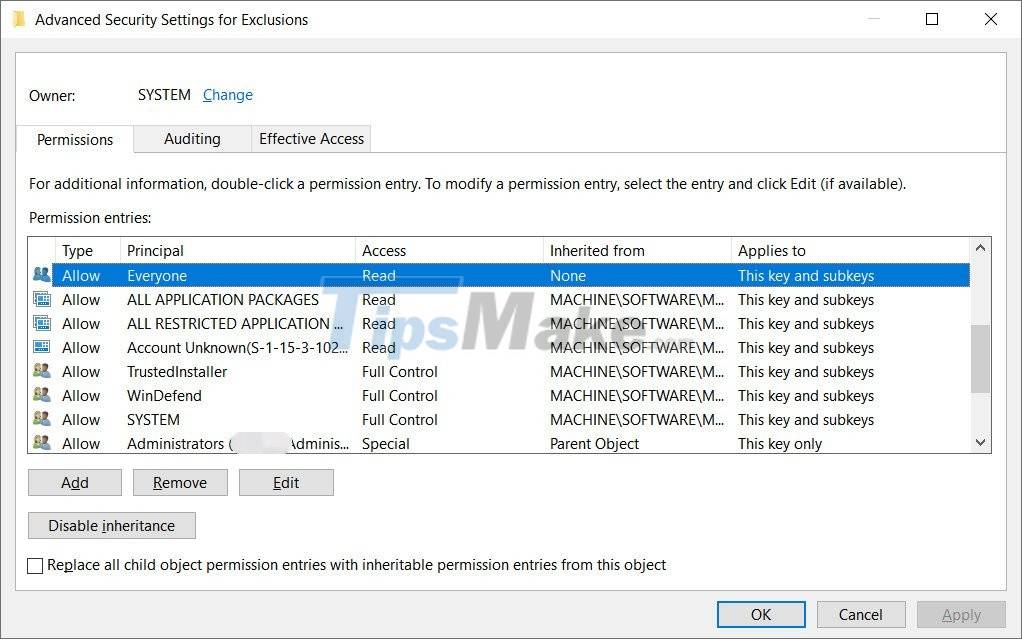Hackers take advantage of Microsoft Defender's 8-year-old weakness to bypass the virus detection system
Like any other antivirus, Microsoft Defender allows users to add exclusions (locally or on a network) on their system. When scanning for viruses, Microsoft Defender will ignore these excluded areas and folders.
Often users will create exclusion zones to prevent anti-virus software from affecting the functionality of a genuine application that is mistakenly detected as a virus.
Security researchers discovered that the list of locations excluded from Microsoft Defender's scanning was not protected at all. This results in any local user being able to access this list.
 Hackers take advantage of Microsoft Defender's 8-year-old weakness to bypass the virus detection system Picture 1
Hackers take advantage of Microsoft Defender's 8-year-old weakness to bypass the virus detection system Picture 1
Regardless of permissions, users can access the Registry and find a list of locations excluded from the scan. The hacker will then plant the virus in those excluded locations and execute the malicious code without fear of detection.
Because the directory listings and exclusions are different for each user, there is no universal way to determine this for all computers. This also makes it easier for hackers to hide their behavior.
The news site BleepingComputer has conducted testing to confirm the problem. Testing showed that a ransomware executed from an excluded folder was able to run and encrypt the entire computer without any hindrance or warning from Microsoft Defender.
A security consultant discovered this problem 8 years ago and realized the advantages it brought to hackers.
Due to the long time of existence, and Microsoft has not taken action to patch the error, users and administrators should actively protect themselves by correctly configuring the exclusion area on the server and local machine via group policies.
You should read it
- Microsoft Defender ATP will be available on iOS and Android later this year
- Instructions for using Windows Defender
- Compare Microsoft Defender and Bitdefender
- Microsoft Defender for Endpoint encountered an error that could not be started on Windows Server
- Windows Defender is disabled or inactive, this is a fix
- 3 ways to scan Windows 10 system-wide viruses with Microsoft Defender
- How to fix errors cannot open Windows Defender on Windows 7/8/10
- Use Windows Defender with Command Prompt on Windows 10
- Microsoft Defender for Business launched, mainly aimed at the small and medium business community
- Shadow Defender - Download Shadow Defender here
- How to use Windows Defender to scan programs that do not want PUP?
- Fix Microsoft Defender 0x80073b01 on Windows 10
May be interested

Microsoft's source code signature control system is easily bypassed by Zloader malware

Detecting a series of vulnerabilities can help hackers disable metal detectors at airports

How to block Windows Defender from sending data to Microsoft

How to check if a URL is safe?

This is how Windows 11 and Windows 10 21H2 combat PrintNightmare, ransomware and other threats

Patches of dangerous vulnerabilities being exploited by hackers contain dangerous holes and then continue to be exploited by hackers






 Latest Anime Defenders code and how to enter code
Latest Anime Defenders code and how to enter code Download Aegis Defenders, a super cool action game, for free
Download Aegis Defenders, a super cool action game, for free Error in a series of popular virus scanning tools
Error in a series of popular virus scanning tools Hackers take advantage of the panic in the Corona virus epidemic to spread malware on the internet
Hackers take advantage of the panic in the Corona virus epidemic to spread malware on the internet Destroy the autorun virus in USB or on PC with 4 simple ways
Destroy the autorun virus in USB or on PC with 4 simple ways Intrusion detection system (IDS) (Part 1)
Intrusion detection system (IDS) (Part 1)